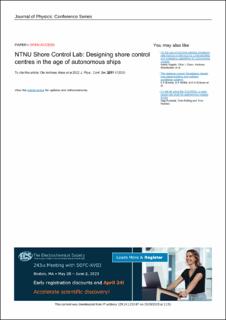| dc.contributor.author | Alsos, Ole Andreas | |
| dc.contributor.author | Veitch, Erik Aleksander | |
| dc.contributor.author | Pantelatos, Leander Spyridon | |
| dc.contributor.author | Vasstein, Kjetil | |
| dc.contributor.author | Eide, Egil | |
| dc.contributor.author | Petermann, Felix-Marcel | |
| dc.contributor.author | Breivik, Morten | |
| dc.date.accessioned | 2023-03-15T11:54:19Z | |
| dc.date.available | 2023-03-15T11:54:19Z | |
| dc.date.created | 2022-08-11T23:40:35Z | |
| dc.date.issued | 2022 | |
| dc.identifier.issn | 1742-6588 | |
| dc.identifier.uri | https://hdl.handle.net/11250/3058367 | |
| dc.description.abstract | As highly automated ships become unmanned, their operators will move into shore-based control centers. In the last years, NTNU has built an advanced and flexible research infrastructure for performing research on autonomous ships and the monitoring and control of these. The infrastructure comprises of (1) the milliAmpere1 and milliAmpere2, which are two all-electric autonomous urban passenger ferries equipped with advanced sensors and equipment for autonomous navigation, (2) the Shore Control Lab, a flexible shore control center, where operators can monitor and control a fleet of autonomous ships, (3) a lab section for researchers to give instructions to operators in the control center, and to record, observe, and analyze their behavior, (4) an observation room adjacent to the control room for stakeholders to observe ongoing experiments in the control room, (5) the ferry simulator Autoferry Gemini that allows researchers to create challenging or high-risk scenarios where operators can be stress tested without being a danger to ship, crew and passengers, (6) the mixed reality lab MRLAB, where we can test physical designs of urban autonomous passenger ferries in a virtual environment, and (7) a dock for passenger handling and with inductive charging capabilities. In this paper, we first describe the research infrastructure's purpose and scope of operation, as well as the technical design, physical setup, and equipment. Secondly, we present a roadmap for the development of the research infrastructure to meet the future research challenges for autonomous ships and the supervision and control of these. Thirdly, we present a number of research questions that are going to be explored in the lab in the years to come. | en_US |
| dc.language.iso | eng | en_US |
| dc.publisher | IOP Publishing | en_US |
| dc.rights | Navngivelse 4.0 Internasjonal | * |
| dc.rights.uri | http://creativecommons.org/licenses/by/4.0/deed.no | * |
| dc.title | NTNU Shore Control Lab: Designing shore control centres in the age of autonomous ships | en_US |
| dc.title.alternative | NTNU Shore Control Lab: Designing shore control centres in the age of autonomous ships | en_US |
| dc.type | Peer reviewed | en_US |
| dc.type | Journal article | en_US |
| dc.description.version | publishedVersion | en_US |
| dc.source.journal | Journal of Physics: Conference Series (JPCS) | en_US |
| dc.identifier.doi | 10.1088/1742-6596/2311/1/012030 | |
| dc.identifier.cristin | 2042566 | |
| dc.relation.project | Norges forskningsråd: 313921 | en_US |
| dc.relation.project | Norges forskningsråd: 296527 | en_US |
| dc.relation.project | Norges forskningsråd: 331921 | en_US |
| dc.relation.project | Norges forskningsråd: 309230 | en_US |
| cristin.ispublished | true | |
| cristin.fulltext | postprint | |
| cristin.qualitycode | 1 | |

